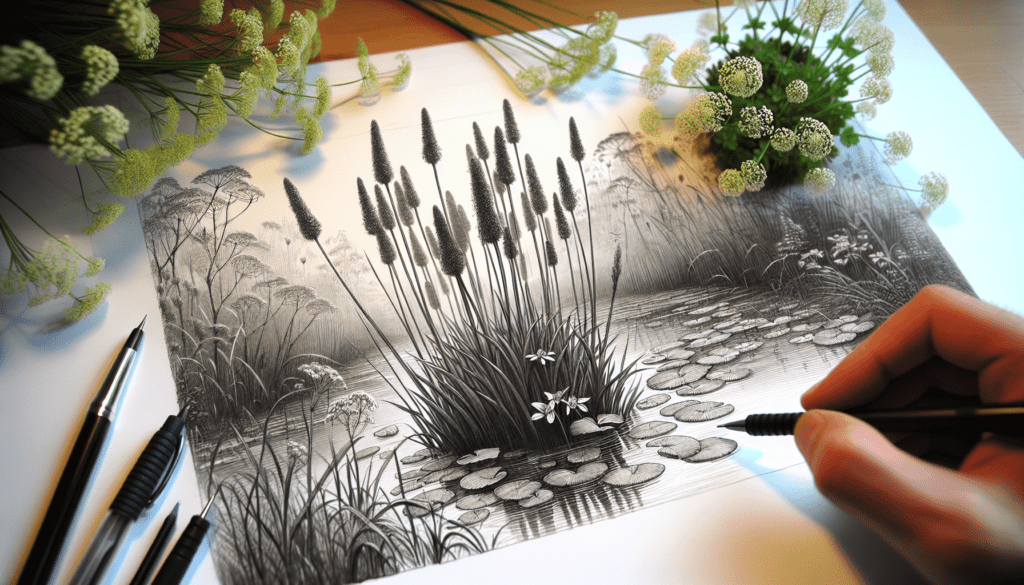In your exploration of aquatic botany, you may have encountered the term “Common Rush.” The article that follows elucidates the nature of this intriguing species, detailing its physical characteristics, ecological significance, and practical applications. As a reader, you will be taken on a journey through the underwater botanical world and will discover the diverse dimensions of the aquatic plant known as the Common Rush.

Basic Description of Common Rush
Common Rush, a widely recognized aquatic plant, plays an integral role in numerous ecosystems across the globe. In this section, we will delve into its botanical nomenclature, physical attributes, and its typical habitats.
Botanical Name and Family
The botanical name for Common Rush is Juncus effusus, which is part of the Juncaceae family—commonly known as the rush family. It is the most prevalent species within the genus Juncus and it is characterized by its cylindrical, hollow, and unjointed stems.
Physical Characteristics and Structure
Common rush is a perennial aquatic plant with an inordinate vigor. The plant can grow from 1 to 3 feet in height. It presents dark green, round stems and leaves that are twisted or spiraled. It features small brown flowers crowning its stems from summer to early fall. These clusters of flowers distinguish it from other members of the rush family.
Global Distribution and Habitats
Global in distribution, Juncus effusus thrives in places with moist and damp soil conditions. It predominantly inhabits regions such as wetlands, marshes, and the edges of ponds and streams. It can be found across North America, Europe, Asia, and parts of Africa and South America.
Reproductive Characteristics of Common Rush
The reproductive nature of common rush involves predictable patterns of flowering, pollination, and seed dispersal helping it maintain its ubiquity in many ecosystems.
Flowering and Fruiting Season
The flowering period of Juncus effusus typically occurs from June to September. During this time, it produces an abundance of minute, brown flowers packed into tight clusters located at the top of the plant. The fruiting stage begins shortly after, extending into late fall.
Pollination Mechanisms
The pollination process of the common rush involves the transfer of pollen from its anthers to stigmas. The plant is contextually classified as an autogamous species—it relies for the most part, on self-pollination. Insects could also assist in this process on occasions but are not the primary pollinating agents.
Seed Dispersal Methods
The seed dispersal mechanisms of common rush typically involve both water and wind. In water-conducive environments, the seeds float away from the parent plant, establishing themselves in new locations. On the other hand, in drier environments, the seeds are dispersed by wind.
Ecological Impact of Common Rush
In ecosystems, the common rush plays multiple roles and has noteworthy interactions with wildlife. It also affects water quality due to its water-filtering capabilities.
Role in Ecosystems
In ecosystems, common rush plays an essential role in stabilizing pond banks and stream edges, helping prevent erosion. The plant also acts as a critical nutrient sink, absorbing excessive nutrients that can otherwise cause algal bloom.
Interactions and Relationships with Wildlife
Common rush propitiates a symbiotic relationship with many wildlife species. The plant provides nesting and sheltering ground for birds and small mammals, while its seeds serve as a food source for waterfowl. Particularly, the thickets of common rush shields are used by marsh wrens for building their nests.
Effect on Water Quality
Common rush has a significant impact on water quality. Its fibrous root systems help filter out pollutants from runoff, improving water quality in the process. This plant species also aids in mitigating the potentially damaging effects of nutrient-rich farm runoff.

Common Rush Cultivation
Cultivating common rush necessitates knowledge of its growth prerequisites, propagation techniques, and maintenance procedures.
Ideal Growth Conditions
This species thrives best in moist or wet soils but can tolerate a variety of soil types. It prefers full to partial sun exposure. It can withstand both acidic and alkaline soil conditions.
Propagation Methods
The common rush procreates naturally through seeds or rhizomes. Cultivated propagation can be achieved by either dividing established clumps or planting fresh seeds.
Maintenance and Control Techniques
Maintenance of common rush typically involves periodic trimming to keep it from growing out of control. If necessary, this species can be controlled using both chemical and non-chemical methods, such as manual removal or application of approved herbicides.
Common Rush Uses and Applications
Historically and contemporarily, common rush has various applications in ornamental design, crafting, and possibly in medicine.
Traditional and Historical Uses
Traditionally, the stems of the common rush have been used for various purposes. They have been woven into mats and baskets, and used as roofing and floor coverings. The plant was also used in the production of rushlights, a predecessor to candles.
Modern Uses and Applications
Today, common rush holds ornamental significance. Its robust nature and unique structure make it a sought-after element in wetland and pond landscape designs. It’s also increasingly used in constructed wetlands for wastewater treatment owing to its water-filtering properties.
Potential Medical and Therapeutic Uses
Certain therapeutic uses of the common rush, as part of traditional medicine, have also been reported. It is believed to have mild sedative properties and has been used as a herbal tea for people with sleeping disorders. It is also used in the treatment of certain digestive disorders. However, more rigorous research is required to validate and further investigate these possible health benefits.
Pests and Diseases Associated with Common Rush
Just like any other plant, the common rush is susceptive to pests and diseases which could hamper its growth.
Common Diseases
Common rush, as a robust species, doesn’t succumb to many diseases. However, it can occasionally be affected by fungal diseases such as rusts and blotches.
Typical Pests
The common rush isn’t significantly plagued by pests but could sometimes be consumed by livestock and wildfowl. In some cases, aphids and other sucking insects may also dwell on the plant.
Control Methods and Prevention Strategies
Preventive plant health care practices, like maintaining good growing conditions, can help reduce the plant’s vulnerability to diseases and pests. Infected parts of the plant should be removed and discarded to prevent the spread of the disease. In the case of pest infestation, biological or chemical control methods can be employed, as necessary.
Conservation Status and Threats to Common Rush
As an integral part of many ecosystems, it’s essential to understand the conservation status and threats to this plant.
Current Conservation Status
Common rush is not currently under any significant conservation threat. Its wide distribution and hearty nature keep it off most conservation watch lists.
Major Threats
There are no major universal threats to the common rush. However, in certain regions, its populations may come under threat due to changes in local habitats like draining of wetlands, water pollution, or overgrazing by livestock.
Conservation and Recovery Strategies
Given the current robust status of the common rush, specific conservation strategies aren’t urgently required. However, the preservation of its natural habitats and limitations placed on disruptive human activities can help ensure their long-term survival.
Research on Common Rush
Extensive research has been and continues to be conducted on the common rush.
Recent Scientific Studies
Recent studies have focused on the utilisations of Juncus effusus in constructed wetlands for wastewater and stormwater treatment. This is due to its extraordinary ability to filter water and absorb excess nutrients.
Implications and Future Research Directions
The results from these studies signify a promising future for the use of common rush in environmental cleanup projects. Future research could focus on optimizing the use of this plant in this context and uncovering possible genetic modifications to boost its pollutant-absorbing capabilities.
Significant Contributions to Field
Research on common rush has culminated in essential insights into this plant’s extensive ecological role. It has heightened awareness about the significance of preserving wetlands and ponds and the biological mechanisms underlying self-pollination and seed dispersal in water plants.
Regulations and Laws Regarding Common Rush
Despite its wide-ranging benefits, certain laws and regulations can sometimes govern the cultivation and proliferation of common rush.
Local, National, and International Regulations
Regulations relating to common rush are usually localized, given the plant’s wide distribution and non-invasive nature. In certain regions, landowners may need permits to remove or alter common rush growth, especially in regulated wetlands.
Penalties for Violations
Violations of regulations can lead to penalties, commonly in the form of fines. The severity of violations may amplify depending on whether the violation resulted in significant ecological damage.
Responsibility of Landowners and Managers
Irrespective of regulations, landowners and managers should strive to maintain a balance in common rush growth, minimising any potentially detrimental impacts while optimising the environmental benefits this plant offers.
Interesting Facts about Common Rush
Common rush indeed has features and historical significance that makes it noteworthy.
Unique Features and Characteristics
One notable feature of the common rush is its fibrous root system, which allows for excellent soil binding and water filtration. Also, its ability to self-pollinate significantly aids its vast distribution and survival.
Cultural and Historical Significance
Common rush has paramount historical value, especially in European cultures. Traditionally used to make rushlights, mats, and baskets, this plant has been a part of people’s livelihoods for centuries.
Superstitions and Folklore
There are also numerous folklore and superstitions associated with the common rush. In some cultures, the plant is believed to ward off evil spirits when placed at home entrances. Therefore, note that, while some might view it as a mere wetland plant, it carries a particular charm in cultures around the world.
